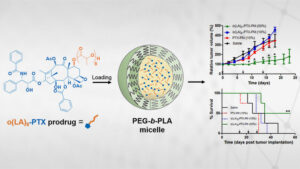Abstract
Poly(ethylene glycol)-block-poly(d,l-lactic acid) (PEG-b-PLA) micelles affect drug solubilization, and a paclitaxel (PTX) loaded-PEG-b-PLA micelle (PTX-PM) is approved for cancer treatment due to injection safety and dose escalation (Genexol-PM®) compared to Taxol®. However, PTX-PM is unstable in blood, has rapid clearance, and causes dose-limiting toxicity. We have synthesized a prodrug for PTX (7-OH), using oligo(lactic acid) as a novel pro-moiety (o(LA)8-PTX) specifically for PEG-b-PLA micelles, gaining higher loading and slower release of o(LA)8-PTX over PTX. Notably, o(LA)8-PTX prodrug converts into PTX by a backbiting reaction in vitro, without requiring esterases. We hypothesize that o(LA)8-PTX-loaded PEG-b-PLA micelles (o(LA)8-PTX-PM) has a lower Cmax and higher plasma AUC than PTX-PM for improved therapeutic effectiveness. In Sprague-Dawley rats at 10 mg/kg, compared to o(LA)8-PTX-PM (10% w/w loading) and PTX-PM (10%), o(LA)8-PTX-PM (50% w/w loading) produces a 2- and 3-fold higher plasma AUC0-24 of PTX, lactic acid-PTX, and o(LA)2-PTX (o(LA)0-2-PTX), respectively. For o(LA)8-PTX-PM at 10 and 50% w/w loading, PTX and lactic acid-PTX are major bioactive metabolites, respectively. Fast prodrug conversion of o(LA)8-PTX in vivo versus in vitro (by backbiting) suggests that o(LA)8 is a good substrate for esterases. At 60 mg/kg (qwx3), o(LA)8-PTX-PM (50%) has higher antitumor activity than o(LA)8-PTX-PM (10%) and PTX-PM (10%) in a syngeneic 4T1-luc breast tumor model based on measurements of tumor volume, 4T1-luc breast tumor bioluminescence, and survival. Importantly, intravenous administration of o(LA)8-PTX-PM is well tolerated by BALB/c mice. In summary, oligo(lactic acid)8-PTX is more compatible than PTX with PEG-b-PLA micelles, more stable, and may expand the role of PEG-b-PLA micelles from “solubilizer” into “nanocarrier” for PTX as a next-generation taxane for cancer.

Cited by
This article is cited by 9 publications
-
Repp, L., Skoczen, S. L., Rasoulianboroujeni, M., Stern, S. T., & Kwon, G. S. (2023). Plasma Stability and Plasma Metabolite Concentration-Time Profiles of Oligo(Lactic Acid)8-Paclitaxel Prodrug Loaded Polymeric Micelles. The AAPS journal, 25(3), 39. https://doi.org/10.1208/s12248-023-00807-4
-
Rasoulianboroujeni, M., Repp, L., Lee, H. J., & Kwon, G. S. (2022). Production of paclitaxel-loaded PEG-b-PLA micelles using PEG for drug loading and freeze-drying. Journal of controlled release : official journal of the Controlled Release Society, 350, 350–359. https://doi.org/10.1016/j.jconrel.2022.08.032
-
Repp, L., Unterberger, C. J., Ye, Z., Feltenberger, J. B., Swanson, S. M., Marker, P. C., & Kwon, G. S. (2021). Oligo(Lactic Acid)8-Docetaxel Prodrug-Loaded PEG-b-PLA Micelles for Prostate Cancer. Nanomaterials (Basel, Switzerland), 11(10), 2745. https://doi.org/10.3390/nano11102745
-
Cheng, M., Liu, Q., Gan, T., Fang, Y., Yue, P., Sun, Y., Jin, Y., Feng, J., & Tu, L. (2021). Nanocrystal-Loaded Micelles for the Enhanced In Vivo Circulation of Docetaxel. Molecules (Basel, Switzerland), 26(15), 4481. https://doi.org/10.3390/molecules26154481
-
Wan, J., Huang, L., Cheng, J., Qi, H., Jin, J., & Wang, H. (2021). Balancing the stability and drug activation in adaptive nanoparticles potentiates chemotherapy in multidrug-resistant cancer. Theranostics, 11(9), 4137–4154. https://doi.org/10.7150/thno.54066
-
Jin, I. S., Jo, M. J., Park, C. W., Chung, Y. B., Kim, J. S., & Shin, D. H. (2020). Physicochemical, Pharmacokinetic, and Toxicity Evaluation of Soluplus® Polymeric Micelles Encapsulating Fenbendazole. Pharmaceutics, 12(10), 1000. https://doi.org/10.3390/pharmaceutics12101000
-
Jo, M. J., Jo, Y. H., Lee, Y. J., Park, C. W., Kim, J. S., Hong, J. T., Chung, Y. B., Lee, M. K., & Shin, D. H. (2019). Physicochemical, Pharmacokinetic, and Toxicity Evaluation of Methoxy Poly(ethylene glycol)-b-Poly(d,l-Lactide) Polymeric Micelles Encapsulating Alpinumisoflavone Extracted from Unripe Cudrania tricuspidata Fruit. Pharmaceutics, 11(8), 366. https://doi.org/10.3390/pharmaceutics11080366
-
Tam, Y. T., Repp, L., Ma, Z. X., Feltenberger, J. B., & Kwon, G. S. (2019). Oligo(Lactic Acid)8-Rapamycin Prodrug-Loaded Poly(Ethylene Glycol)-block-Poly(Lactic Acid) Micelles for Injection. Pharmaceutical research, 36(5), 70. https://doi.org/10.1007/s11095-019-2600-0
-
Gu, Y., Ma, J., Fu, Z., Xu, Y., Gao, B., Yao, J., Xu, W., Chu, K., & Chen, J. (2019). Development Of Novel Liposome-Encapsulated Combretastatin A4 Acylated Derivatives: Prodrug Approach For Improving Antitumor Efficacy. International journal of nanomedicine, 14, 8805–8818. https://doi.org/10.2147/IJN.S210938